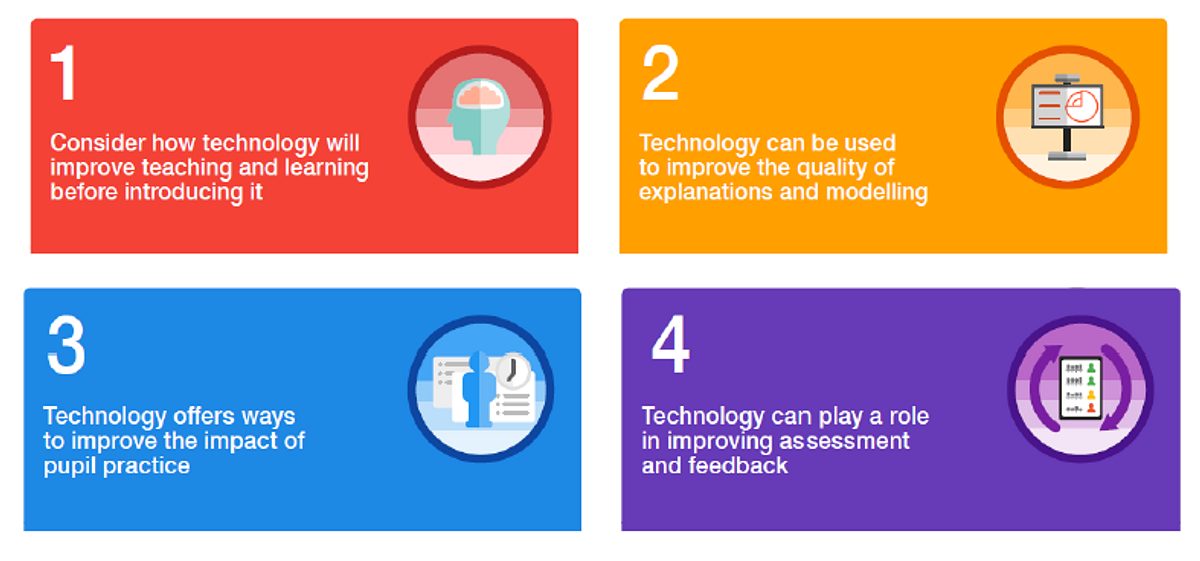
Using Digital Technology
by James Siddle ( Kyra Research School)
The guidance report from the Education Endowment Foundation, ‘Using Technology to Improve Learning’ is outlined below. The report offers four practical, evidence-based recommendations to support teachers and senior leaders in developing their use of technology to support learning.
Having sat on the advisory panel, it was fascinating to see how the guidance developed from an initial philosophical discussion around the approach to using technology in the classroom, to a systematic review of the evidence, which then led to the carefully chosen recommendations.
Chicken or Egg?
“Do you think we should go back to having an ICT suite or invest in tablets?”
This was a question I was asked recently by a headteacher wanting to improve the use of technology in their school. What’s good about the new guidance is that it drills down into questions such as these and encourages schools to first ‘define the problem’ and it’s very clear about what comes first: technology is ‘much more likely to improve learning if it is introduced in response to an identified need.’
The guidance offers a useful set of questions to inform the rationale for how technology will improve learning – these could form part of an implementation model for schools, and indeed the report makes clear the key role that implementation (and thus by default, evaluation) is when schools consider change.
Pedagogy Trumps the Kit
The evidence for effective teacher modelling is strong and we can find it in various guidance reports already – meta-cognition and Key Stage 1 and 2 Literacy for example – and it’s no surprise to find it in the technology guidance: Pedagogy trumps the kit!
Technology can help with worked examples; it can help with dual coding; it can help create shared texts; technology can help supplement experiments in science – but the pedagogy must be evidence-based in the first instance. What’s apparent is that if you want to model writing using a visualiser or an interactive whiteboard then this guidance report would be best used in conjunction with other guidance reports to ensure the approach is evidence-based. All the EEF guidance reports can be found here:
https://educationendowmentfoundation.org.uk/tools/guidance-reports/
How can Technology help with Assessment?
The etymology of the word ‘assessment’ comes from the Latin assidere – to ‘sit by’. I recently observed a teacher using technology to facilitate retrieval practice – the teacher ‘sat beside’ the Year 3 pupils as they retrieved a range of geographical information using an online programme. A pupil came to the interactive white board and took a low stakes, interactive quiz. By observing the learning, the teacher was able to offer timely feedback to correct misconceptions and, at the same time, record assessment data which would then translate later into whole class feedback. As the guidance makes clear: How teachers use information from assessments, and how pupils act on feedback, matter more than the way in which they are collected and delivered.
To Spend or not to Spend?
In the guidance report’s overview of the research, schools can find useful examples when trying to weigh up the financial implications against the intended learning outcomes. For example the efficacy trial of ABRA tested an online toolkit for improving reading outcomes in Year 1.
https://educationendowmentfoundation.org.uk/projects-and-evaluation/projects/abracadabra-abra-pilot/
The intervention had an ICT arm and a non-ICT arm (delivered by a teacher assistant or class teacher). Both intervention groups performed better than the control group (although the non-ICT version performed slightly better with all pupils, they performed equally with pupil premium children). The question then might become one of budget and resources for schools leaders – do I have the human resources to deliver the intervention or do I use technology?
Thus the guidance in the report is clear:
- Decisions about whether to introduce technology should also include an analysis of the costs of implementing the technology, alongside the expected benefits. These costs include the upfront and any on-going requirements.
An Issue of Workload
One of the fears I know many teachers have is that using technology can create extra workload when simply trying to learn how to use the tech, but what if it could improve teacher workload longer term? Recommendation four draws attention to this point:
“Using technology can increase the accuracy of assessment, or the speed with which assessment information is collected, with the potential to inform teachers’ decision-making and reduce workload.”
As the report states: ‘if technology is used to make assessment more efficient and effective, this can also help reduce teacher workload’. I know teachers who record assessment data linked to diagnostic assessments by scanning with their iPads. At my own school, we have delivered feedback via tablets, the teacher recording feedback during lessons, which the pupils can then access again and again.
The report is an excellent guide to effective use of technology but perhaps the overriding message seems to bring us back to the ‘banana principle’: ‘it’s not what you do; it’s the way that you do it’.
Please enter some content for your news story here.

